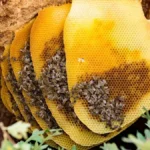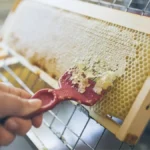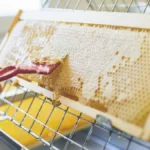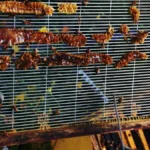In beekeeping, there are arguments for and against using plastic beeswax foundations. Beehive wax foundation is nearly essential to most types of beekeeping. In this article, we explore the benefits and disadvantages of plastic foundation compared to natural wax foundation.
What Is Bee Comb Foundation?
Bee comb foundation is a sheet of material embossed with the hexagonal shapes of the cells that bees will draw out into comb.
Foundation can be made from a sheet of pure beeswax, beeswax with an embedded wire/plastic support, or a sheet of plastic sprayed with a thin layer of beeswax. The wax spray tricks the bees into being able to see the foundation as “beeswax”.
Why Do We Need A Comb Foundation?
Bees will build a beehive their way if we give them a chance. There are some very simple ways where we can almost not use foundation for beekeeping. So-called foundationless beekeeping allows a beekeeper to get bees to make combs in the desired places – sometimes.
However, if you want to quickly, and efficiently get bees to build combs where you want them – in the middle of your frames – foundation combs are very important. We can also strengthen the combs by running wires through the foundation. When the bees draw the comb, this wire makes the frames strong.
Strengthened combs, that are reinforced with wire allow us to extract honey in centrifugal extractors. Reinforced combs also allow us to migrate bees. Unreinforced combs would just break off the combs. If you migrated your bees on a truck, you would get to the destination and find a mess of brood and honey dribbling out of the entrance of the hive.
How Plastic Bee Foundation Works
When comparing plastic vs wax bee foundation, it is important to first understand how plastic bee foundation works.
The plastic bee foundation consists of either sheets or complete frames. In the sheet format, it is a sheet of honeycomb embossed plastic that can be clipped into a frame. The complete frame format is a frame cast with the foundation and the frame as a single unit.
Typically, the foundation is then lightly painted or sprayed with a very thin layer of beeswax. The frame is later inserted into a hive. The bees will normally figure it out and draw the comb.
Advantages Of Plastic Bee Foundation
The complete frames with the plastic cast as a single unit have a slightly bigger area to rear brood or store honey. If you are able to raise a few percent more bees per frame this has economic advantages. Similarly, if you can store a few ounces more of honey per frame this also makes a difference.
The plastic foundation is very strong – it is difficult to break a drawn plastic frame, and the comb is robust and strong. You can really bounce the combs around, and spin them at high speed in an extractor to get the maximum honey out.
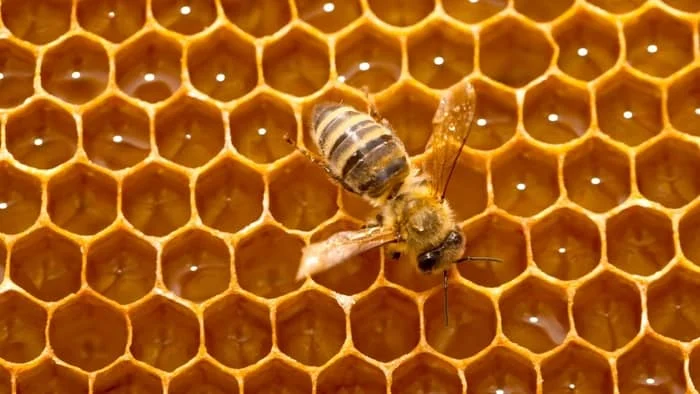
Disadvantages Of Plastic Bee Foundation
Bald Patches On Comb
In certain cases, the bees can refuse to draw sections of comb. This will result in so-called bald patches in the comb.
Sometimes, when extracting combs, the comb can separate from the foundation, and the results is also a bald patch. These can normally be fixed by painting a bit of wax on the bald patches to get the bees to draw comb there.
Plastic Leaches Into The Honey and Into The Brood
All plastics slowly leach compounds into the environment around them. To understand this, let us take a closer look at the structure of plastics.
The Structure Of Plastics
A plastic consists of a polymeric substance that is then rendered flexible by a plasticizer. If we imagine a jelly, the polymer is gelatine, which makes the jelly set, and the plasticizer is the water sugar and flavor you put in your jelly.
Plastics are a very big family of very complex chemicals. Formulations change and every now and then research emerges to show that one chemical was bad, and this is replaced by another. Some are endocrine disruptors.
The Risk Of Plastic Compounds Leaching Into Honey
Plastics degrade – that is a known fact. Plastic varies in quality from manufacturer to manufacturer, and there is actually very little oversight as to the quality of things which end up in the market. It is safe to say that there is a risk when using plastic comb that plastics and or plasticizers can leach into your honey and bees.
Natural Honey Wax Foundation
Beeswax is, bizarrely enough, a natural plastic. It is a complex mixture of natural fatty alcohols, waxes, hydrocarbons, fats, sterols, esters, and a whole range of really clever natural chemicals made by the bees.
Beeswax does leach small amounts of beeswax compounds into your honey, and into your food. Interestingly, all of these compounds are actually very good for you.
Find more information about How To Install Wax Foundation In Frames?
Advantages Of Natural Honey Wax Foundation
It is a natural bee product and you are just using what the bees have always used.
It is easy to work with.
If the combs have a blowout in the extractor the bees will normally just fix the comb when you put it back in the hive. You will not get bald spots in your combs.
It is edible – you can cut chunks of comb out and eat it.
Disadvantage Of Natural Honey Wax Foundation
It is not as strong as plastic foundation.
There is a small risk of bringing disease in with wax foundation. This can be averted by making your own.
It melts on hot days if your hives are not ventilated properly.
Conclusions
When we weigh up the benefits of plastic vs wax bee foundation, we have to look at what our objectives are. Plastic foundation is a good choice for large-scale beekeeping.
If you are a small-scale beekeeper the choices are different. When evaluating the choice of beehive wax foundation to use, the natural honey wax foundation is probably the safer choice. You can market your honey as “plastic-free” and charge a higher price.
The consumer willing to pay more is well enough educated to understand the benefits of natural was beehive foundation.
We hope this article has helped you understand the differences between plastic and wax bee foundation. We hope you have fun choosing what works for you, and if you found this helpful please share!
Read more about: Beehive Frames Without Foundation
Beehive Plastic Foundation FAQs
1. What is the difference between plastic and wax bee foundation?
Plastic foundation is a sheet or frame made from molded plastic, often coated with beeswax to encourage bees to build comb. Wax foundation, on the other hand, is made from natural beeswax and provides a more traditional surface for bees to build upon. Each type has its pros and cons depending on your beekeeping needs.
2. Why do some beekeepers prefer plastic foundation?
Plastic foundation is highly durable and resistant to damage, making it ideal for large-scale beekeeping operations. It can withstand the stress of honey extraction without breaking and is more robust for transport and migration.
3. Is there a risk of plastic leaching chemicals into honey?
Yes, there is a potential risk of plastic foundation leaching chemicals into honey over time. Plastics contain compounds that may degrade and release substances into the hive environment. However, this risk depends on the quality of the plastic and the manufacturing process.
4. How does wax foundation benefit small-scale beekeepers?
Wax foundation is a natural product made by bees and is generally preferred by small-scale or hobbyist beekeepers. It allows for a more traditional, chemical-free approach, and any honey produced can be marketed as “plastic-free,” which may appeal to eco-conscious consumers.
5. Can bees refuse to build comb on plastic foundation?
Yes, bees can sometimes leave “bald patches” on plastic foundation, especially if they are not adequately coated with beeswax. This can slow down comb-building, but reapplying beeswax to the affected areas usually resolves the issue.
6. What are the advantages of using wax foundation?
Wax foundation is completely natural, easier for bees to work with, and repairs itself if the comb is damaged during honey extraction. Additionally, it is edible, and any wax remnants can be safely consumed along with honey.
7. Is wax foundation more prone to melting?
Yes, wax foundation can melt in hot temperatures if the hive is not properly ventilated. Plastic foundation does not have this issue, making it more suitable for beekeepers in warmer climates or those who may have less control over hive conditions.
8. Which foundation type is better for disease prevention?
Plastic foundation is less likely to harbor diseases compared to wax foundation, which can sometimes carry pathogens if not properly sterilized. However, beekeepers who produce their own wax foundation can mitigate this risk.
9. Which foundation is better for honey production: plastic or wax?
Plastic foundation is generally better for commercial honey production due to its strength and durability, allowing for more efficient extraction. Wax foundation is preferred by smaller-scale beekeepers who value natural methods and may market their honey as plastic-free.

Dr. Garth A. Cambray is a Canadian/South African entrepreneur and beekeeper with 28 years of experience in apiculture and specializes in adding value to honey. His Ph.D. research developed a new advanced continuous fermentation method for making mead that has resulted in a number of companies globally being able to access markets for mead. His company, Makana Meadery, exports honey mead to the USA where it is available to discerning connoisseurs. He has also developed technologies to commercially manufacture organic honey vinegar in Zambia for export globally. He holds a few patents globally in the ethanol industry and believes in technology and knowledge transfer for human development and environmental sustainability. One of his proudest achievements is the fact that the wind farm he started at one of his old apiary sites has essentially made his hometown carbon neutral.


